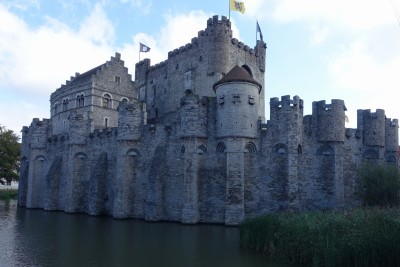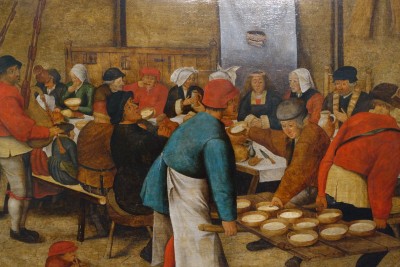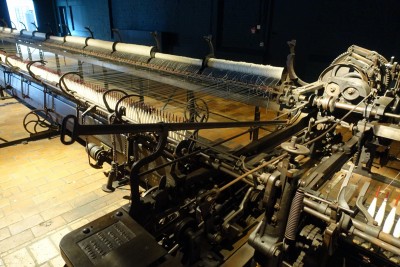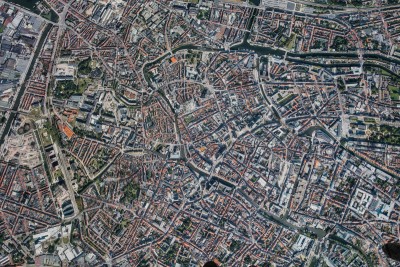Friendly and Engaging Ghent
(vero;2023-Oct-15)
Ghent was the second city we visited during this trip. After the crowds and "museum-feel" of Bruges, we enjoyed its friendly vibe and no-fuss attitude. The city centre is easy to navigate and we spent a lot of time in museums, all very well presented and providing an interesting insight into the city's past.
 As for Bruges and Antwerp, access to the sea has always been primordial for Ghent to benefit from trade and ensure wealth. Nowadays the city is the third seaport in Belgium (after Antwerp and Zeebrugge), connected to the North Sea in the Netherlands via the Ghent-Terneuzen Canal. Our P+R was at the southern end of the port and we could observe the continuous traffic of lorries transporting goods from the port onto the roads and further afield.
As for Bruges and Antwerp, access to the sea has always been primordial for Ghent to benefit from trade and ensure wealth. Nowadays the city is the third seaport in Belgium (after Antwerp and Zeebrugge), connected to the North Sea in the Netherlands via the Ghent-Terneuzen Canal. Our P+R was at the southern end of the port and we could observe the continuous traffic of lorries transporting goods from the port onto the roads and further afield.
Ghent was spared destruction during the two World Wars and has retained a well preserved medieval centre. We loved the Graslei and Korenlei quays along the river Leie as well as the skyline of the towers of St Niklaas Church, the Belfry and the St Bavo cathedral. The Gravensteen castle, unexpected in the middle of town, is quite a sight as well (alas, it was not included in our Belgium Museum Pass); we were disappointed by the Prinsenhof district though, we were expecting it to feel a bit more romantic! We recommend stopping at the tourist office near the Gravensteen to collect a map with some walks to explore the city.
Of course, we visited the museum of Fine Arts (MSK) and inspired by our museum pass we pushed the doors of the city museum (STAM) and the industry museum, two very interesting visits where we learnt a lot about the city history. We were particularly impressed by the level of industrialisation of Ghent in the 18th and 19th centuries, when the textile industry flourished and when weaving mills, breweries, printing workshops were scattered all around the city centre.
Many people come to Ghent to see the famous Adoration of the Mystic Lamb by the Van Eyck brothers (known as the Ghent Altarpiece) on display in the St Bavo cathedral. We were not the exception but decided otherwise after we entered the cathedral: we were immediately put off by the commercial exploitation surrounding this masterpiece and the fact that the cathedral has been changed into a museum with only the nave accessible to non-paying visitors; all other paintings, retables, stained-glass windows and statues located in the side chapels of the choir are now hidden behind this pay-wall. We knew where to find Flemish art: in the Fine Arts museums and we bought a book about the Ghent Altarpiece instead.
Practicalities
We were based in the city of Dendermonde, quite in the centre of a triangle Ghent-Antwerp-Brussels, from where we visited exactly those three cities. We visited Ghent twice, driving north to the E17 motorway and reaching the city via the R4-ring. We parked for free at the WEBA-Decathlon Park and Ride which provides a free shuttle into the city centre every 15 minutes. Be aware though that this shuttle bus is not running on Sundays or Public Holidays. It takes 15 minutes to reach the centre stopping at the Sint-Jacobs church near the Friday market square.
Beware: Ghent has a LEZ (Low Emission Zone). If you are a foreigner and have a number plate from a country other than Belgium or Netherlands, you MUST register your vehicle (for free) if you think you will enter the zone during your stay. To do this, go to this website, to check if your vehicle is OK and to register.
The entry fees for museums and some monuments are quite high and we recommend buying either the Ghent City Card for 38€/48h or 44€/72h (consecutive days including public transport) if you plan to visit more than one or two of them or even best if you plan to visit more than one city in Belgium, the Belgian Museum Pass for 59€ valid for one year (not including all museums though, so make sure that the ones you want to see are included, search this page by city). Prices were valid at our time of visit in September 2023; the Ghent city card can be purchased at the tourist office or at a participating museum; the Belgian Museum Pass can be purchased online or at a participating museum. Don't forget to check the opening times before setting off: many museums are closed on Mondays (but not all).
Do not forget to check our photo gallery dedicated to Ghent to discover views of the city and have a peek inside some of our preferred museums. We have prepared a short description of the best to whet your appetite below:

MSK - Museum of Fine Arts: the museum's collection consists of some 9000 artworks, dating from the Middle Ages to the 20th century with over 600 on permanent display and a focus on Flemish art. Re-opened after renovation in 2007 it has also introduced a new way of presenting the numerous exhibits by interrupting the chronological suite of rooms with rooms dedicated to a certain theme mixing works from different periods which we found a bit annoying.
They have also an area dedicated to restoration where we could see teams at work currently restoring the five upper panels of the opened Ghent Altarpiece.
Don't forget to check our photo gallery dedicated to this museum.
STAM - City Museum: we really enjoyed the STAM. One of the highlights is the first room where the floor is featuring a huge picture of Ghent and its suburbs seen from above (300 m2 large) on which visitors can walk (with overshoes to protect it), kneel and explore the city. It is amazing and really sharp, crisp and clean and we had much fun retracing our steps or looking for a certain building or monument we had come across while strolling through the city.
The other rooms are dedicated to the chronological development of the city, from the Roman times to today with a projection into the future. The exhibits are well spaced (no overload) and there are interactive screens at strategic points dedicated to ca. six exhibits where the visitor can click on their picture and learn about them with descriptions available in Flemish, French and English.

Industry Museum: we wouldn't have visited the Industry Museum if it hadn't been for the fact that it was included into our Belgium Museum Pass. And it would have been a pity.
The museum is located in the impressive building of an old cotton mill and presents three permanent exhibitions which bring the industrial past of Ghent back to life. The first floor (level 3) is dedicated to the conditions of the people who worked in the factories of the town in the 18th and 19th centuries with topics such as rural exodus, child labour, female ownership of business, the impact of mechanisation on their work or the fight for social progress. It is well presented and interesting.
The two next levels are dedicated to the textile and printing industries both featuring real machines, some of them still in working order, quite an impressive display. You might be lucky and come at a time when some of the machines are running.
Want to read more? Go back to Touristy and Enchanting Bruges or go on to Lively and Affluent Antwerp or go up to Blog
$ updated from: Blog.htxt Mon 28 Apr 2025 14:55:37 trvl2 — Copyright © 2025 Vero and Thomas Lauer unless otherwise stated | All rights reserved $




